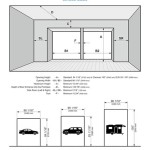How To Transform Your Garage With A Fresh Paint Job On Its Own
A garage, often an overlooked space, can be significantly enhanced with a fresh coat of paint. Transforming your garage with a fresh paint job on your own is a cost-effective way to improve its aesthetics, protect its surfaces, and potentially increase your property value. This article provides a comprehensive guide to successfully undertaking this project, ensuring a professional-looking result.
Before embarking on any painting project, thorough preparation is paramount. This initial phase determines the quality and longevity of the finished work. Rushing this process can lead to unsatisfactory results and require more work in the long run.
Preparation: The Foundation of a Successful Paint Job
The first step in preparing the garage for painting involves clearing the space. Remove all items from the garage, if possible. For immovable objects, cover them securely with drop cloths or plastic sheeting. This will prevent paint splatters and spills from damaging your belongings. Consider renting a storage unit or temporarily storing items in another part of the house if space is limited.
Next, thoroughly clean all surfaces to be painted. This includes walls, ceilings, and the garage door, both inside and out. Use a solution of warm water and mild detergent to remove dirt, grease, and grime. A pressure washer can be used for exterior surfaces, but be mindful of the water pressure to avoid damaging the material. Rinse surfaces thoroughly and allow them to dry completely before proceeding.
After cleaning, inspect the surfaces for any damage, such as cracks, holes, or peeling paint. Repair these imperfections before painting. Use a patching compound to fill holes and cracks, and sand the repaired areas smooth. Scrape away any loose or peeling paint with a paint scraper. Feather the edges of the scraped areas to create a smooth transition. For larger areas of damage, consider consulting a professional contractor.
Masking is another crucial part of the preparation process. Use painter's tape to protect areas that you don't want to paint, such as trim, windows, and door frames. Apply the tape carefully, pressing it firmly against the surface to create a tight seal. This will prevent paint bleed and ensure clean lines.
Finally, consider priming the surfaces. Primer is a base coat that helps the paint adhere better, provides a uniform surface for the topcoat, and can block stains. Use a primer specifically designed for the type of surface you are painting. Apply the primer evenly, following the manufacturer's instructions. Allow the primer to dry completely before applying the paint.
Once the preparation is complete, you can move on to selecting the right paint and tools for the job. The type of paint and tools you choose will affect the final appearance and durability of the paint job. Using high-quality materials is generally a worthwhile investment.
Selecting the Right Paint and Tools
Choosing the correct type of paint is essential for achieving a long-lasting and aesthetically pleasing finish. For garage walls and ceilings, a latex-based paint is generally recommended. Latex paint is durable, easy to clean, and relatively inexpensive. Choose a paint with a satin or semi-gloss finish, as these finishes are more resistant to moisture and dirt than matte finishes.
For garage floors, a specialized epoxy paint is recommended. Epoxy paint is extremely durable and resistant to chemicals, oil, and wear. It also creates a smooth, glossy surface that is easy to clean. Before applying epoxy paint, ensure that the floor is properly prepared, as epoxy paint requires a clean, dry, and slightly porous surface for optimal adhesion.
The garage door, whether made of wood, metal, or fiberglass, requires a paint that is specifically designed for exterior use. Choose a paint that is weather-resistant and can withstand temperature fluctuations. For metal garage doors, use a paint that is formulated to prevent rust. For wooden garage doors, use a paint that is flexible enough to accommodate the wood's natural expansion and contraction.
In addition to paint, you will need a variety of tools to complete the project. These include paintbrushes, rollers, paint trays, extension poles, drop cloths, sandpaper, masking tape, and a paint scraper. Invest in high-quality brushes and rollers, as they will provide a smoother finish and last longer. Choose brushes and rollers that are appropriate for the type of paint you are using. For latex paint, use synthetic brushes and rollers. For oil-based paint, use natural bristle brushes and rollers.
An extension pole is useful for painting ceilings and high walls, allowing you to reach these areas without having to climb a ladder constantly. Use drop cloths to protect the floor and other surfaces from paint splatters. Sandpaper is used to smooth rough surfaces and prepare them for painting. Masking tape is used to protect areas that you don't want to paint. A paint scraper is used to remove loose or peeling paint.
Safety equipment is also essential. Wear safety glasses to protect your eyes from paint splatters. Wear a respirator to protect your lungs from paint fumes. Wear gloves to protect your hands from paint. Ensure that the garage is well-ventilated to minimize exposure to paint fumes.
With the preparation complete and the materials assembled, the actual painting can begin. Proper painting techniques contribute significantly to the quality of the finished project.
Painting Techniques for a Professional Finish
Start by painting the trim, if applicable. Use a paintbrush to apply the paint to the trim, working in long, even strokes. Be careful not to get paint on the surrounding walls. If you do, wipe it off immediately with a damp cloth.
Next, paint the ceiling. Use a roller with an extension pole to apply the paint to the ceiling. Work in sections, overlapping each stroke slightly. This will ensure that the ceiling is evenly coated. Be careful not to apply too much paint at once, as this can cause drips.
After the ceiling, paint the walls. Use a roller to apply the paint to the walls, working in long, even strokes. Start at the top of the wall and work your way down. Overlap each stroke slightly to ensure that the walls are evenly coated. Use a paintbrush to paint the corners and edges of the walls.
Apply two coats of paint to all surfaces, allowing the first coat to dry completely before applying the second coat. This will provide better coverage and durability. Follow the manufacturer's instructions for drying times.
For the garage door, start by painting the edges and any recessed panels with a brush. Then, use a roller to apply the paint to the flat surfaces. Work in long, even strokes, overlapping each stroke slightly. Apply two coats of paint, allowing the first coat to dry completely before applying the second coat.
When painting a metal garage door, consider using a rust-inhibiting primer before applying the paint. This will help prevent rust and prolong the life of the paint job. If the garage door has windows, mask them off carefully before painting to prevent paint from getting on the glass.
After painting, carefully remove the masking tape while the paint is still slightly wet. This will prevent the paint from peeling off with the tape. If any paint has seeped under the tape, touch it up with a small brush.
Allow the paint to dry completely before replacing any items in the garage. This will prevent the paint from being damaged. Clean your brushes and rollers thoroughly after each use. Use water to clean latex paint and mineral spirits to clean oil-based paint. Store your brushes and rollers in a clean, dry place.
Proper ventilation is essential throughout the painting process. Open windows and doors to allow fresh air to circulate. If necessary, use a fan to improve ventilation. Avoid painting in humid or extremely hot weather, as this can affect the drying time and quality of the paint.
By following these steps, individuals can successfully transform their garage with a fresh paint job on their own, resulting in a more attractive, functional, and well-maintained space.

How To Use Garage Floor Paint Transform Your Home

13 Awesome Garage Makeovers That Will Give You Envy

Creating Your Own Diy Paint Booth At Home

Garage Renovations Make The Most Of Your Space Great Additions Construction Company

How To Paint A Garage Floor Clean And Scentsible

How To Use Garage Floor Paint Transform Your Home

20 Pro Tips For A Nicer Garage Interior Living

How To Paint Garage Floors With 1 Part Within The Grove

20 Pro Tips For A Nicer Garage Interior Living

Transform Your Unfinished Garage Into Usable Space
Related Posts








